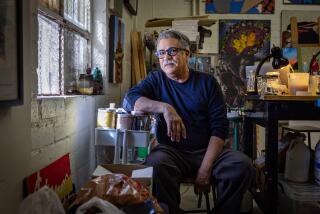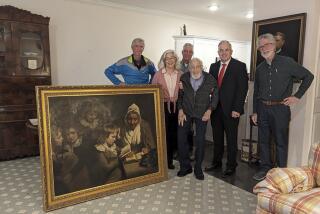On View: ‘White on Black: The Modernist Prints of Paul Landacre’
In 1933 America was staggering through the Great Depression, and Angelenos Jake Zeitlin and Delmer Daves organized a small group to support an artist they believed in, Paul Landacre. Each contributed $100 a year — that went a long way in those days — which awarded them a new print every month. Zeitlin ran an antiquarian book store, which included a small art gallery, and Daves was a budding Hollywood writer who would later direct the film noir classic “Dark Passage” (1947) and the original “3:10 to Yuma” (1957).
“I think they were kindred spirits, my father was always very involved in the arts,” says Debby Richards, Daves’ daughter and a Pasadena resident. Twenty years ago she inherited the bulk of the Landacre prints her father had collected, and 18 of them have been lent to the exhibition “White on Black: The Modernist Prints of Paul Landacre” at the Pasadena Museum of California Art through Feb. 24. It’s a modest exhibition, featuring 29 woodcut prints and two drawings mostly from the ‘30s, but large enough to reveal Landacre’s exquisite precision of line and elegance of composition.
FOR THE RECORD:
Paul Landacre: An article in the Nov. 18 Arts & Books section about an exhibition of prints by the late artist Paul Landacre at the Pasadena Museum of California Art said that the Huntington Library had lent several pieces to the show. The library lent one piece. —
Born in Ohio in 1893, Landacre moved to California for his health. He eventually settled in Echo Park with his wife, Margaret McCreery. While he had taken life drawing classes at the Otis Art Institute, he was largely self-taught. “There weren’t a lot of people working in woodcuts,” says Jessica Smith, curator of American art at the Huntington, which lent one piece to the show. “It’s physically demanding, and calls for planning carefully — once you make the cut into the wood, that’s that.” He eventually became known nationally, through his prints and through book illustrations, which won a number of prizes.
FALL ARTS PREVIEW: Critic’s Picks
Landacre first sketched out his designs. Gordon McClelland, the show’s guest curator, was able to borrow a pencil drawing and a value study done as preliminaries to the print “Wayne’s Bird,” an odd E.T.-looking sculpture that stood on a friend’s desk. “He stylized things very obviously,” says McClelland. “When you see the final woodcut, it’s interpreted quite differently from what you see in the drawings.” The meticulous artist did his own printing, using a rich black ink, and the Washington hand press he used, lent by the International Printing Museum in Carson, occupies the middle of the exhibition gallery.
Two of the artist’s favorite subjects were landscapes and the human form. In his landscapes he saw the California terrain as epic, with the human presence small, even puny. A range of mountains dominate “Coachella Valley,” but closer inspection reveals a line of train cars running along the lower half of the print, the engine belching out a long trail of smoke. Mountains are also massive in “Smoke Tree Ranch,” with the house and barns of a ranch tucked into a slope, like bumps on the body of a giant.
Another group of work celebrates the nude, especially the undulating curves of the female form. In “Sultry Day” his wife, Margaret, lies naked in the doorway on a hot day, reading a magazine, while a cat sprawls near her. In “Demeter” figure and landscape become conflated, and a reclining female torso — breasts, leg and arm — becomes hills and valleys.
MORE
INTERACTIVE: Christopher Hawthorne’s On the Boulevards
TIMELINE: John Cage’s Los Angeles
PHOTOS: Arts and culture in pictures
More to Read
The biggest entertainment stories
Get our big stories about Hollywood, film, television, music, arts, culture and more right in your inbox as soon as they publish.
You may occasionally receive promotional content from the Los Angeles Times.






